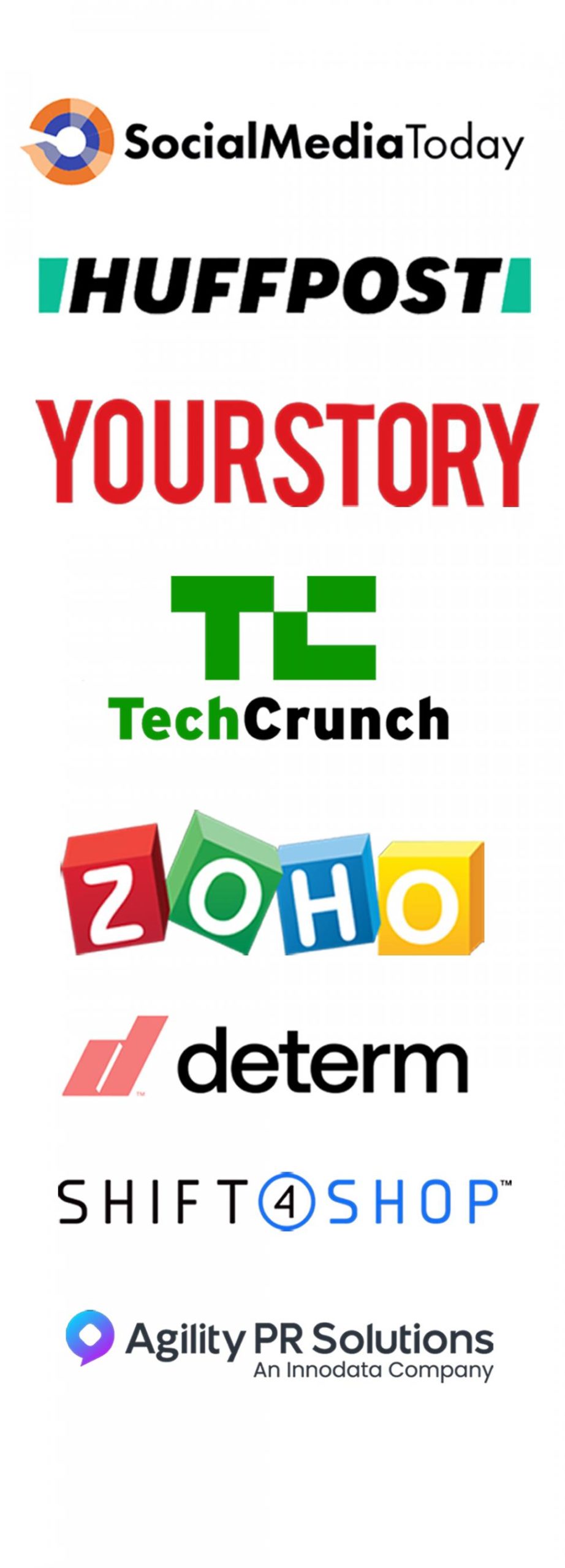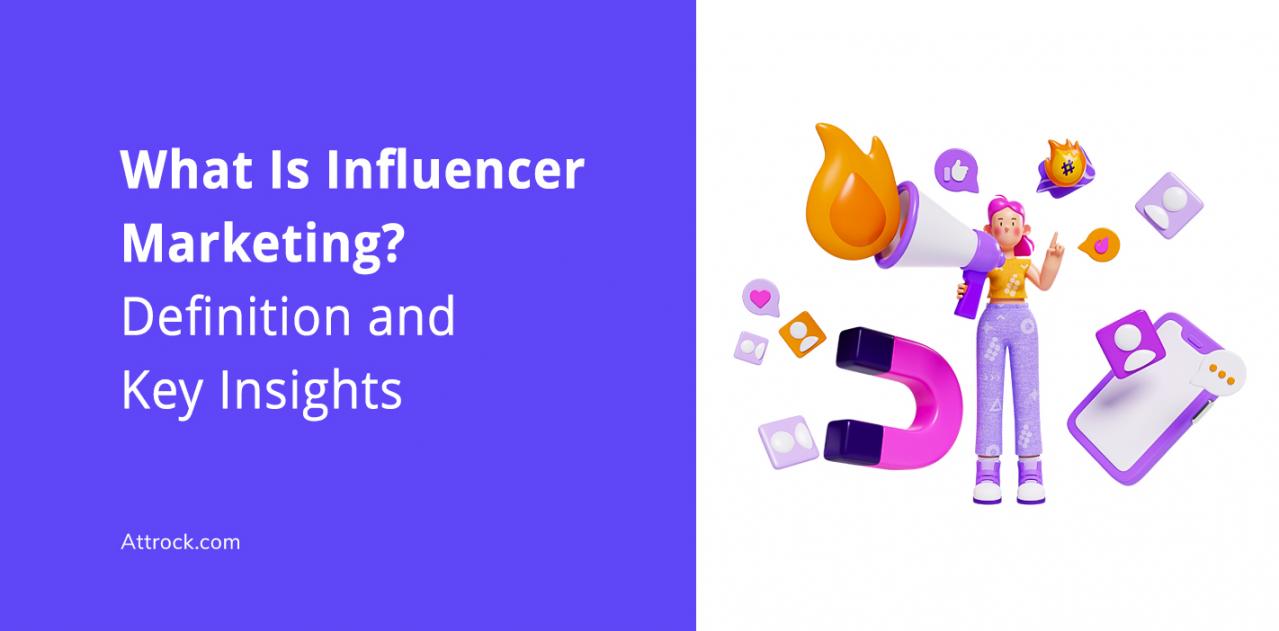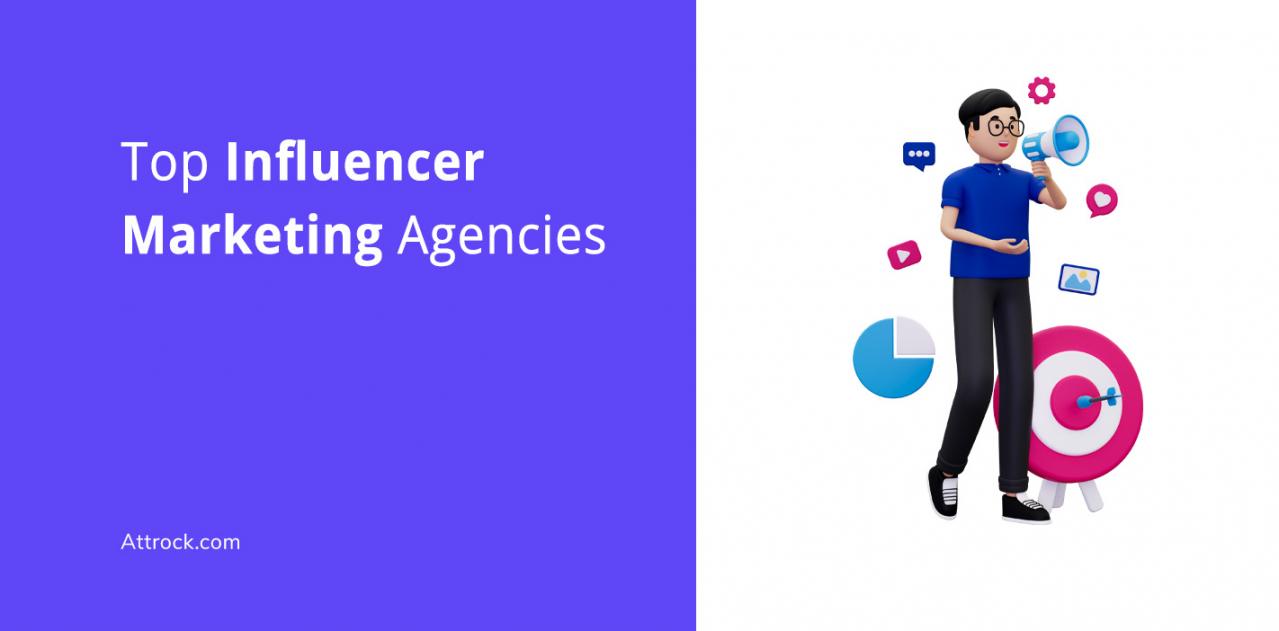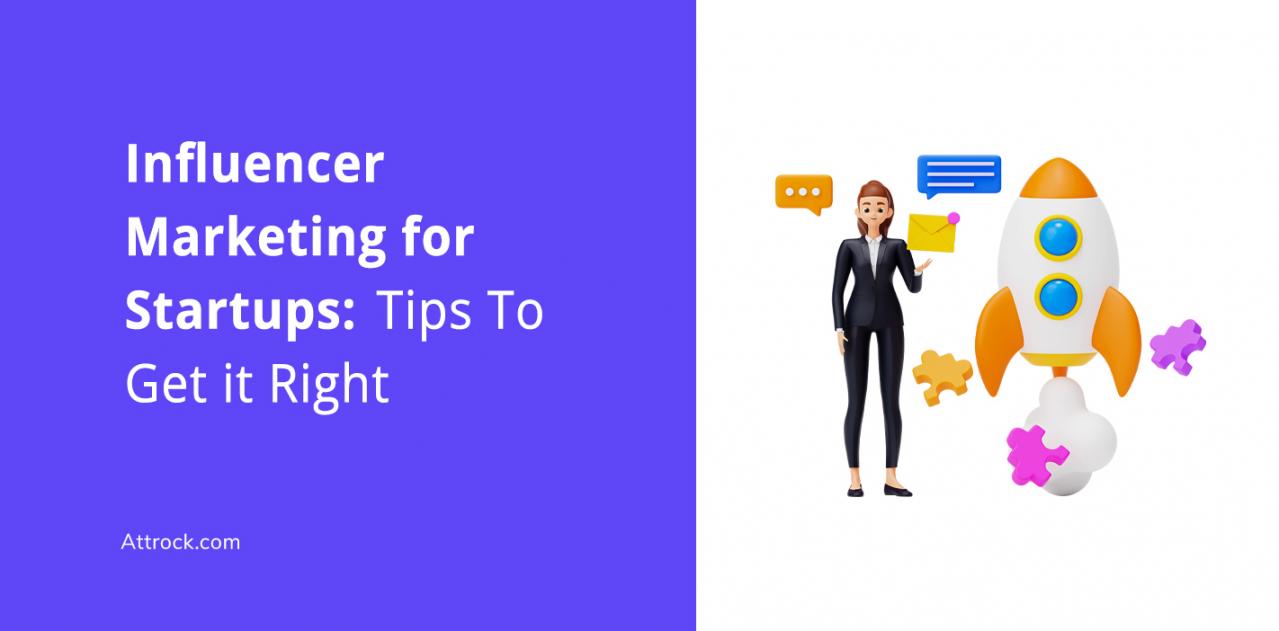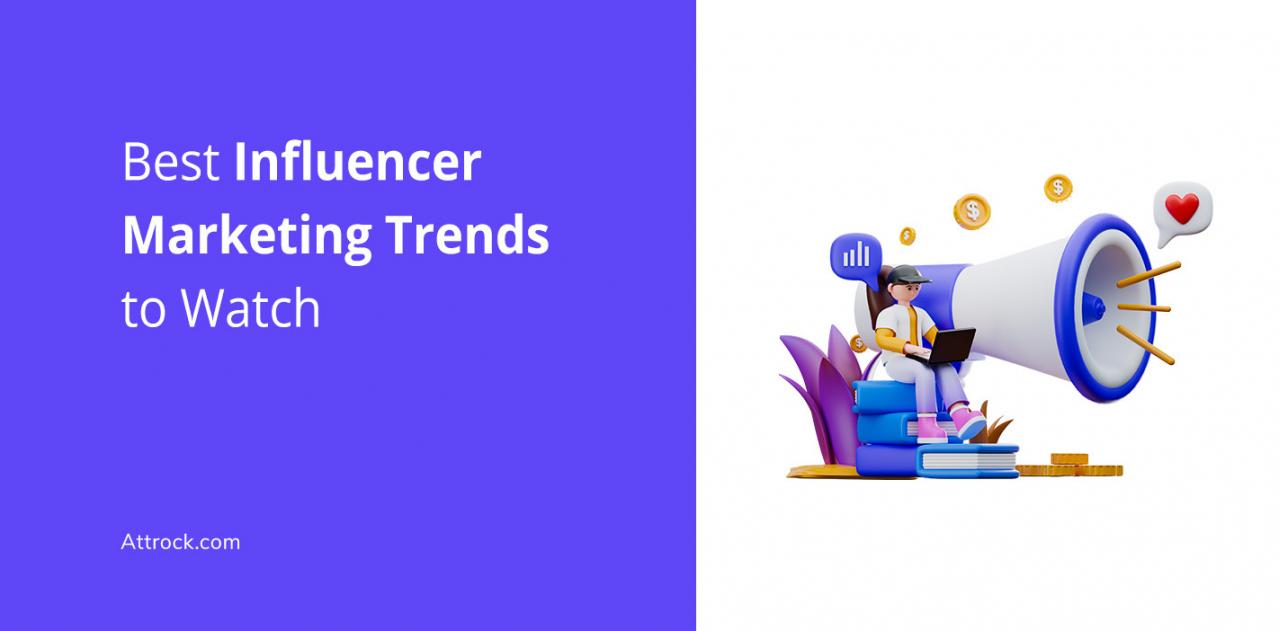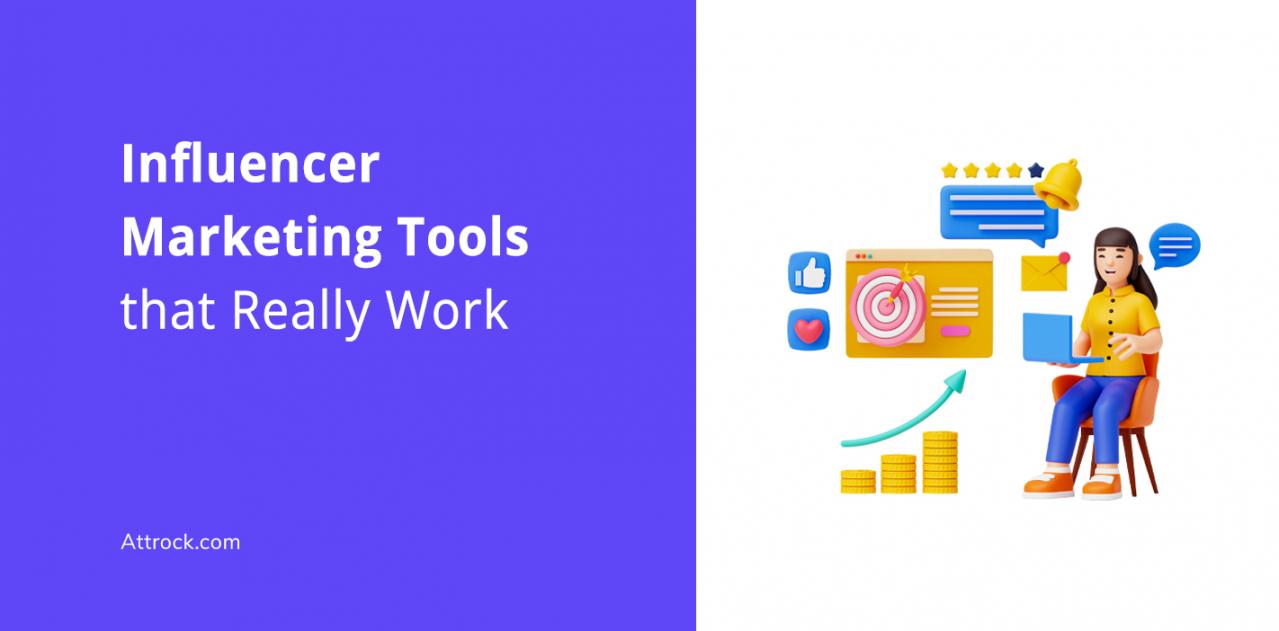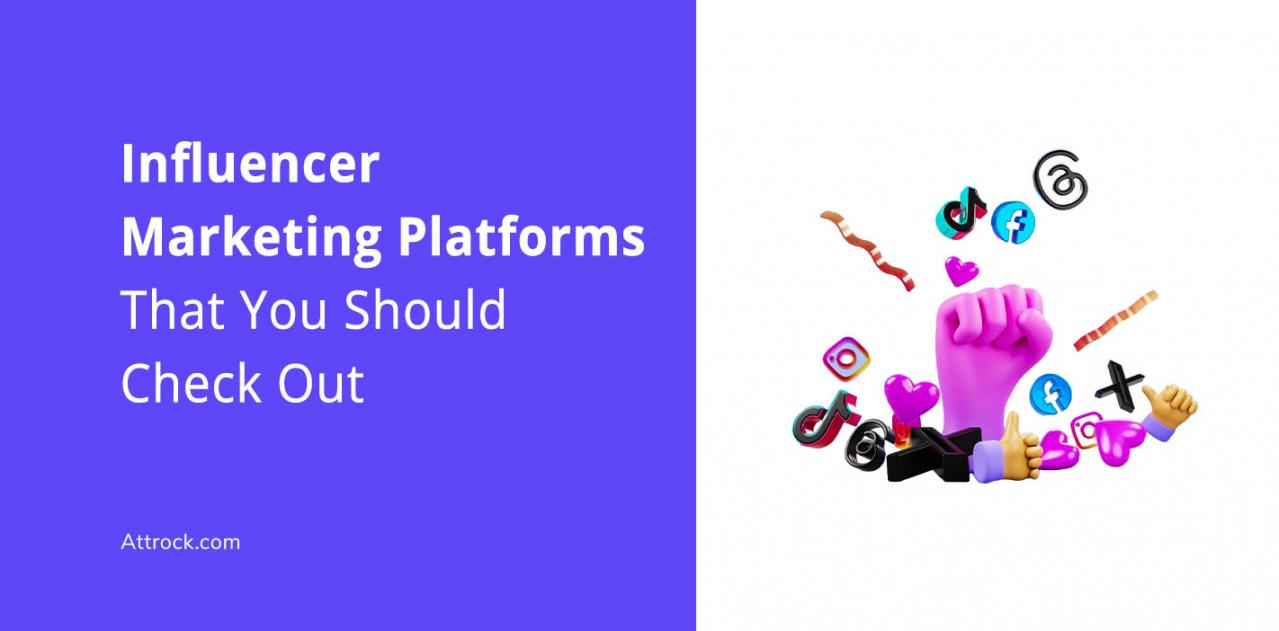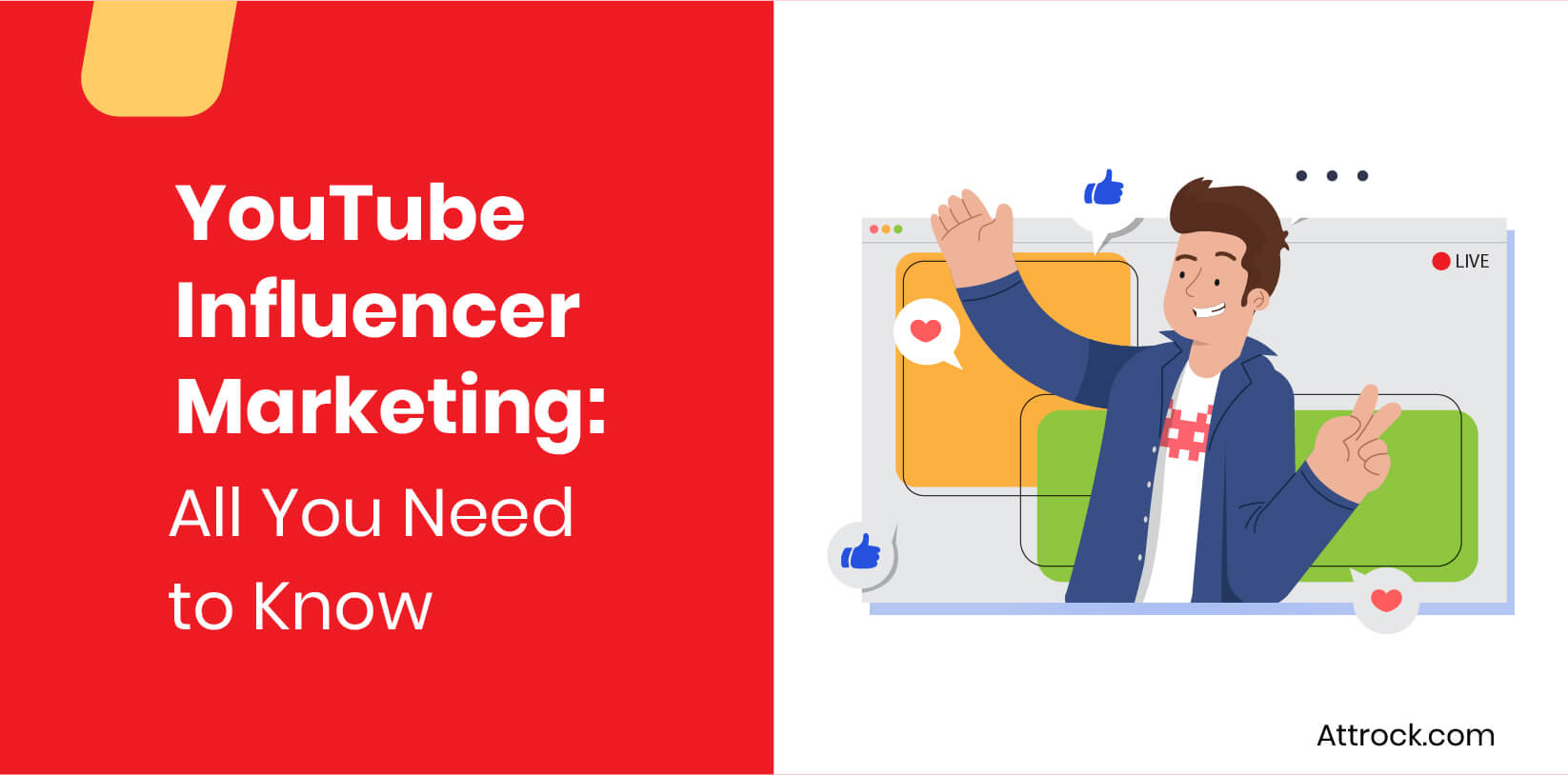Are you curious about influencer marketing pricing in 2025? If so, you're not alone! It's no secret that influencer marketing is gaining popularity, making it a crucial aspect of many brands’ marketing campaigns.
But how much can you expect to pay for influencer marketing? It's a common question and one that many marketers struggle with.
In this blog post, we'll dig deep into influencer marketing pricing and how much you can expect to pay in 2025.
We'll also look at how various social media channels compare, factors affecting influencer marketing pricing, and how to get started with your influencer campaigns.
Let's get started.
Table of Contents
What Is Influencer Marketing?
Influencer marketing is a type of social media marketing that involves working with individuals with a large social media following.
These individuals, known as “influencers,” can help promote your product or service to their followers.
In return, you usually give them some form of compensation, which can be money, free products, or discounts.
The ultimate goal of influencer marketing is to reach a larger audience and generate more sales. It's a way to tap into the influence that these social media users have over their followers. And yes, it works.
Today, customers trust people more than brands. This is supported by a 2024 research showing that 49% of consumers buy from brands because a trusted influencer created social media content about them.
This trust is what makes influencer marketing so effective. When influencers recommend a product or service to their followers, they're more likely to listen because of the bond they share with their followers.
Factors Affecting Influencer Marketing Pricing
While influencer marketing pricing can vary from one influencer to another, several factors play a role in determining how much you'll spend on your campaigns.
Here are some of the critical factors that affect influencer marketing pricing:
1. Size of the Influencer's Following
The most crucial factor that affects influencer marketing pricing is the type of influencer and their following.
Based on their follower count, social media influencers fall into specific categories, such as:
- Nano-influencers: Those with 1,000 to 10,000 followers
- Micro-influencers: 10,000 to 100,000 followers
- Mid-tier influencers: 100,000 to 500,000 followers
- Macro-influencers: 500,000 to 1 million followers
- Mega/celebrity influencers: Those with 1 million or more followers
Many brands prefer forming influencer partnerships with nano influencers because they focus on a specific niche. This means they have specialized knowledge and can engage genuinely with their followers.
They may not have a large follower count compared to other influencer types, but their product recommendations feel more personal than ads. It’s almost like a friend giving recommendations to another friend.
An example of nano influencers offering great value to their followers is Olivia, a dog mom who’s known as @leothecavii on Instagram.
She shares tips on pet care, training, and pet products, and her followers are paw parents who can relate to her posts.
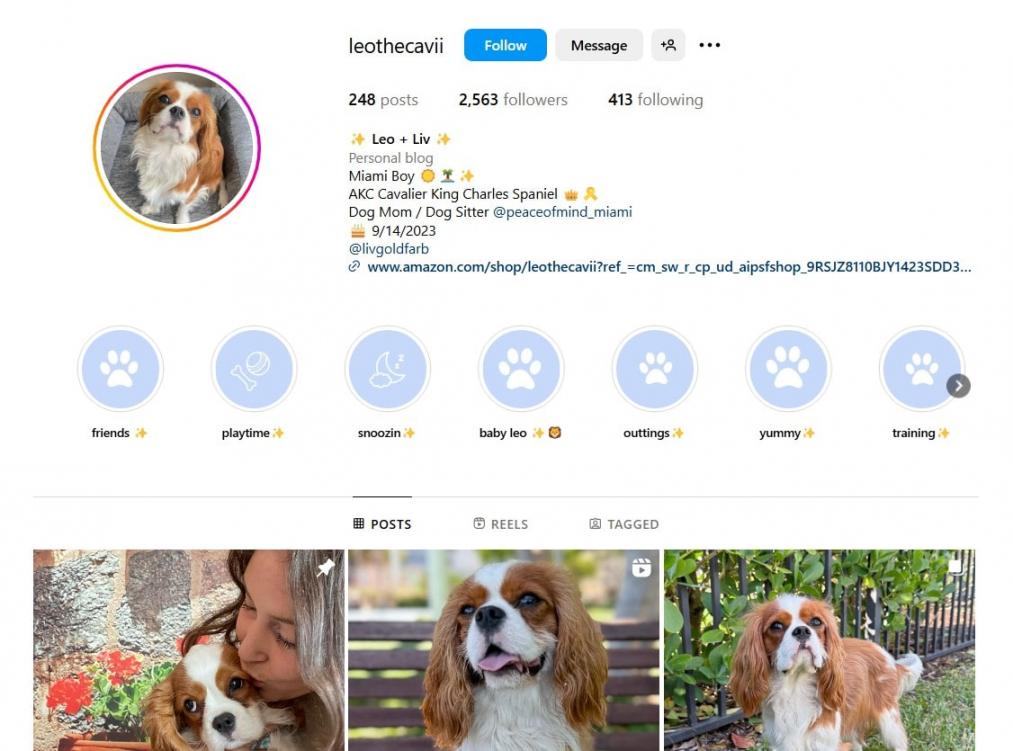
Image via Instagram
As you can imagine, the influencer marketing pricing for nano-influencers will be lower than that charged by macro or mega influencers.
The logic is simple: the more people an influencer has following them, the higher their influencer marketing pricing will be.
Why?
A larger follower count means that the influencer has a greater reach. It also means that the influencer will have more influence over their followers, boosting their ability to increase brand awareness.
This could lead to better conversions and increased sales.
2. Influencer Engagement Rates
The engagement rate is the percentage of an influencer's followers who engage with their posts.
Engagement can include things like likes, comments, shares, and clicks.
You might be thinking, “Why does engagement matter? Shouldn't the size of the influencer's following be the only thing that matters?”
Well, yes and no.
A larger following does not necessarily mean a greater reach for your product. However, if the influencer's posts have a low engagement rate, that reach may not matter as much.
Let's say, for example, that an influencer has 1 million followers, but their posts only receive 10,000 likes on average.
Their engagement rate would be 1%.
Now, let's say another influencer has 100,000 followers, but their posts receive 10,000 likes on average.
Their engagement rate would be 10%.
Even though the second influencer has a smaller following, their posts receive ten times the engagement.
Here’s a chart of Instagram engagement rate benchmarks to guide your influencer partnerships:

Image via Modash
Now, how does the engagement rate affect influencer marketing pricing?
Well, influencers with higher engagement rates tend to be more influential than those with lower engagement rates.
This means that influencers with higher engagement rates will be able to better persuade their followers to take action, whether it’s buying a product or signing up for an email list.
This entitles them to charge higher rates, and that’s why engagement rates are a factor that affects influencer marketing pricing.
3. The Social Media Platform They're Using
The social media platform influencers use can also affect influencer marketing pricing.
This is because different platforms have different levels of reach and engagement per post. For example, content on TikTok may have a better engagement rate than content on Instagram or X.
Research conducted between 2021 and 2023 revealed that TikTok’s average engagement rate per post stood at 2.65% in 2023 across all industries. This is compared to Instagram’s 0.7% and Facebook's 0.15% engagement rate per post.
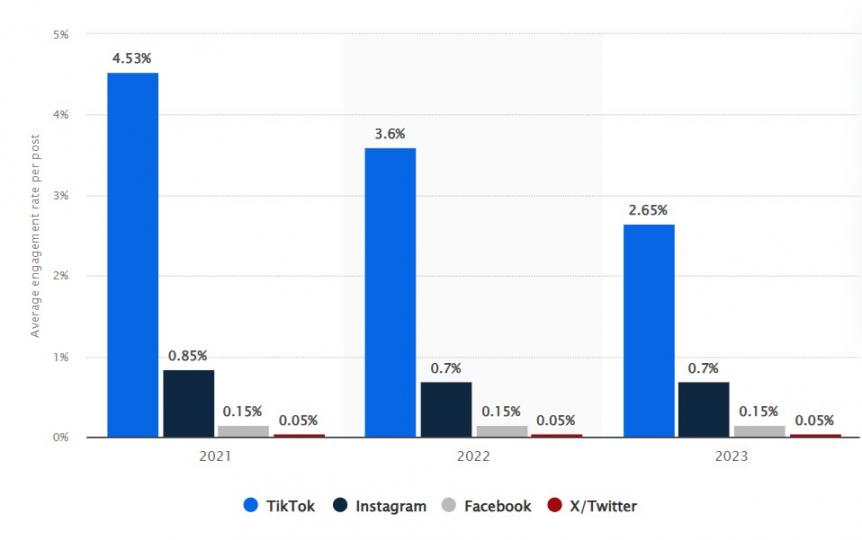
Image via Statista
As mentioned earlier, influencers with better engagement rates will likely charge more, thus raising your influencer marketing pricing. When comparing TikTok versus Instagram, the former has better engagement rates per post, so you can expect to pay more to work with influencers on the platform.
When creating your influencer marketing strategy, it is also worth noting that certain platforms are better suited for certain types of influencer campaigns. For example, YouTube is better for long types of video content than Instagram, which is ideal for short videos, carousel ads, and reels.
Creating a YouTube video lasting 10 minutes takes more time and effort than creating and posting an Instagram reel. As a result, an influencer will typically adapt their influencer marketing pricing to match the content format they produce and the resources needed to accomplish the task.
Overall, different social media platforms have their own advantages and disadvantages, but you can expect that the average influencer marketing pricing is higher for platforms with larger reach and engagement.
4. The Niche They're In
An influencer's niche refers to their specialization or the industry they focus on, and it is an important factor to consider when estimating influencer marketing pricing.
The most popular influencer niches are lifestyle, fashion, and beauty. The influencer marketing pricing will likely be lower, with more influencers to pick from in those niches.
To give you an example, the average influencer marketing pricing for a fashion post is $188, while an entertainment post costs an average of $233.
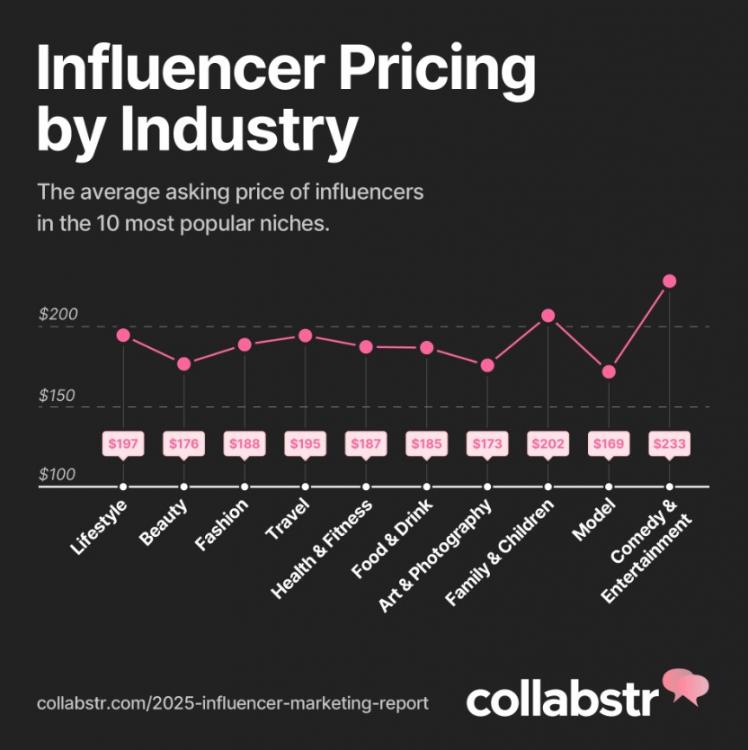
Image via Collabstr
As you can see in the image, influencer marketing pricing is higher in niches like comedy and entertainment, family and children, and travel. Influencers within these niches are popular even outside social media, which categorizes them as celebrities.
So, when you combine their status with the number of followers they have on social media, their influencer rates begin to skyrocket.
With this knowledge, you can then plan your influencer marketing budget to benefit from partnering with such influencers.
Based on Collabstr’s 2024 Influencer Marketing Report, influencer niches like education and technology are now appearing in top searches.
The influencer marketing pricing for these niches may rise, since there may be a small number of influencers in those niches.
For example, finding a technical influencer to work with for content on web development or coding is difficult compared to finding a fashion influencer. This is because technical content takes more time to produce and requires influencers to understand the topic more deeply.
As a result, influencer marketing pricing for technical influencers will be higher than the fashion niche.
5. The Number of Posts or Content Type
The number of posts an influencer makes and the type of social media content they produce will also affect their influencer marketing pricing.
Influencers typically base their rates on how many posts or content pieces they would need to deliver to help meet your marketing goals. However, it’s generally understood that if you want more posts, depending on their type, influencer marketing pricing will likely be higher.
The content type will also affect the cost of influencer marketing campaigns. Content with more visual elements, such as videos, GIFs, and images, will cost more than a simple text-based post.
In short, influencer marketing pricing for videos will be higher because creating a video takes more time and effort than crafting a simple post.
The same goes for influencers who produce long-form content, such as blog posts or product reviews.
The influencer marketing pricing for such influencers is usually more than those who produce short-form content. Again, the reason is that writing a blog post takes more time than creating Instagram content.
The influencer marketing pricing will likely be less if you provide the content or resources used in the process.
6. Other Factors
Some other factors affecting your influencer marketing pricing include:
- Usage Rights – If you repurpose the influencer's content, they'll likely charge you more.
- Exclusivity – If you choose to have an influencer sign an exclusivity clause to prevent them from promoting your competitor's products, you’re likely to pay more. This also costs you more since you are basically telling them to abandon other sources of income.
- Brand Preference – If you specifically want influencer partnerships because of their personal brand recognition, the influencer marketing pricing will likely be higher. This is especially true if you're looking for influencers with a lot of engagement on their profiles.
- Influencer Marketing Agency – If you choose to work with influencer marketing agencies, you might pay more since they often charge an extra fee on top of the original influencer marketing pricing. However, agencies also provide expert influencer marketing services and are usually worth the investment.
Common Pricing Models for Influencer Marketing Campaigns
Now that you know what influencer marketing pricing is based on, let's talk about the different influencer pricing models.
The most common influencer pricing models include:
- Flat-Rate Pricing – Influencers charge a fixed amount for their services. This is usually the most preferred influencer pricing model as it is easy to track and account for influencer marketing costs.
- Cost-per-Click/Acquisition (CPC/CPA) – Influencers are paid based on the number of clicks or acquisitions their content generates. This is a great influencer pricing model for influencers who want to be rewarded for the success of their influencer marketing campaigns.
- Cost-Per-Mille (CPM) – Influencers are paid for every 1000 impressions their content receives. This influencer pricing model is best suited for influencers with a large follower count, such as mid-tier and mega influencers.
- Freebies/Gifts – Influencers receive free products or services as payment for their influencer marketing efforts. This is a great way to incentivize influencers and make them feel valued. However, this model is best suited for nano influencers since they typically have lower rates. They’re more likely to happily collaborate with you in exchange for products.
- Affiliate Marketing – Influencers are paid a commission for every sale made through their influencer marketing campaigns. This influencer pricing model is best suited for influencers with a large following and producing social media content that leads to sales.
Pro Tip: When deciding on influencer marketing pricing models, consider the influencers’ engagement rates and audience demographics to ensure that they are the ideal influencers for your campaign.
Influencer Marketing Cost By Platform
So, now that you know what might affect your influencer marketing costs, here is what you can expect to part with for each social media platform.
Of course, these influencer marketing prices are not set in stone. They are, instead, the most commonly quoted prices by influencers.
The figures are ballpark costs; some influencers may charge way below these rates, and others might quote higher prices.
Instagram Influencer Marketing Pricing
With over 2 billion active monthly users across the globe, Instagram is one of the top channels for your influencer marketing campaign.
Influencer Marketing Hub found that 75.9% of Instagram influencers are nano influencers, making it a cost-effective social platform when it comes to influencer marketing costs.
Instagram influencer marketing pricing is generally $10 per 1,000 followers. But the influencer rates are subject to the factors we discussed above, such as the number of posts and how long it takes to create content on Instagram.
For instance, your influencer campaign budget for a Reel will be more than that of an Instagram post.
Also, sponsored content will cost more because you are leveraging the influencer’s audience to boost brand visibility.
Instagram influencer marketing pricing is as shown in the table below:
| Influencer's Following | Average Instagram Influencer Marketing Pricing Per Post ($) |
| 1,000-10,000 followers | 10–100 |
| 10,000-100,000 followers | 100–500 |
| 100,000-500,000 followers | 500–5,000 |
| 500,000-1,000,000 followers | 5,000–10,000 |
| 1,000,000 followers or more | 10,000+ |
Influencer's Following and Average Cost Per Post ($)
- 1,000-10,000 followers: 10–100
- 10,000-100,000 followers: 100–500
- 100,000-500,000 followers: 500–5,000
- 500,000-1,000,000 followers: 5,000–10,000
- 1,000,000 followers or more: 10,000+
Newbie influencers, or those with less than 10k followers, will often offer to promote your business in exchange for a free gift.
Now, these influencer marketing pricing estimates may seem favorable. However, it is wise to remember that the cost of other types of promotions, such as Instagram stories, reels, Instagram takeovers, or IGTV videos, will vary significantly.
Instagram now supports integration with ecommerce platforms like Shopify and WooCommerce, allowing direct product tagging and shopping features.
This can increase conversion rates from influencer content, making Instagram campaigns more ROI-driven.
As a result, influencers who offer shoppable content or trackable links through affiliate programs may request premium rates, as it’s justified by the direct value they deliver.
TikTok Influencer Marketing Pricing
TikTok is one of the fastest-growing social media apps today.
In just a few years, it has become a worthy competitor to Instagram and YouTube in terms of content sharing.
A survey shows that 42,000 TikTok influencers in the US have between 50 to 100,000 followers, making it one of the most popular influencer marketing platforms.
Being a relatively new platform, there is no standardized data on influencer marketing costs.
However, the average TikTok influencer marketing pricing is $520, based on Collabstr’s Influencer Marketing Report.
TikTok influencer marketing pricing per post is as follows:
| Influencer's Following | Average Cost Per Post ($) |
| 1,000-10,000 followers | 5-25 |
| 10,000-100,000 followers | 25-125 |
| 100,000-500,000 followers | 125-1,200 |
| 500,000-1,000,000 followers | 1,200-2,500 |
| 1,000,000 followers or more | 2,500 and above |
Influencer's Following and Average Cost Per Post ($)
- 1,000-10,000 followers: 5-25
- 10,000-100,000 followers: 25-125
- 100,000-500,000 followers: 125-1,200
- 500,000-1,000,000 followers: 1,200-2,500
- 1,000,000 followers or more: 2,500 and above
Comparing TikTok influencer marketing pricing with Instagram's, you can tell that the latter is less expensive.
Also, many influencers on TikTok are either micro or mega influencers, making this platform a great option for brands with a limited budget for their influencer marketing campaigns.
However, the influencer marketing platform you should use depends on your niche and where your target audience is most active.
Another helpful feature is TikTok’s attribution analytics. It lets brands track how people interact with their ads, such as clicks and views, that lead to conversions. You can also see how your cost per acquisition (CPA) changes over different periods.
This way, brands and influencers can measure ROI precisely. However, with access to performance data, influencer marketing pricing for TikTok may start to increase.
You should also expect custom pricing packages based on predicted performance benchmarks.
YouTube Influencer Marketing Pricing
YouTube influencer rates are usually higher than other social media platforms. This is especially so because of the time and effort spent creating a video.
With the capacity to reach over 1.2 billion users yearly, YouTube makes a perfect place to put your brand in front of a massive audience. The benefits are even more significant if you choose the right type of influencer.
But with the high price tag, choosing which YouTube influencers to work with can be challenging. The average YouTube influencer marketing pricing is as follows:
| Influencer's Following | Average Cost Per Post ($) |
| 1,000-50,000 subscribers | 20-200 |
| 50,000-100,000 subscribers | 200-5,000 |
| 100,000-500,000 subscribers | 5,000-10,000 |
| 500,000-1,000,000 subscribers | 10,000-20,000 |
| 1,000,000 subscribers or more | 20,000+ |
Influencer's Following and Average Cost Per Post ($)
- 1,000-50,000 subscribers: 20-200
- 50,000-100,000 subscribers: 200-5,000
- 100,000-500,000 subscribers: 5,000-10,000
- 500,000-1,000,000 subscribers: 10,000-20,000
- 1,000,000 subscribers or more: 20,000+
You can use these influencer rates to budget for your influencer marketing campaign. But remember, an influencer may charge you depending on the viewership your video will receive.
Aside from traditional sponsorships, YouTube influencers may engage in revenue-sharing deals through affiliate links, product placements, and branded playlists.
This means influencer marketing pricing discussions can extend beyond one-time payments to include commission structures or long-term content partnerships.
So, if you’re looking for a long-term influencer partnership or series-style content, you can negotiate more favorable terms. Just ensure your influencer marketing campaign ideas align with the influencer’s long-term goals.
Facebook Influencer Marketing Pricing
Another popular influencer marketing space is Facebook, thanks to its over 3.07 billion users and a variety of Facebook marketing tools for brands and influencers.
Its popularity is among the major factors that affect influencer marketing pricing on the platform. The influencer marketing spend for campaigns on Facebook rises significantly as the number of followers increases.
To give you a clear picture of the cost of working with Facebook influencers, here are estimates for Facebook influencer marketing pricing:
| Influencer's Following | Average Cost Per Post ($) |
| 1,000-10,000 followers | 2-250 |
| 10,000-50,000 followers | 250-1250 |
| 50,000-500,000 followers | 1250-12,500 |
| 500,000-1,000,000 followers | 12,500-25,000 |
| 1,000,000 followers or more | 25,000+ |
Influencer's Following and Average Cost Per Post ($)
- 1,000-10,000 followers: 2-250
- 10,000-50,000 followers: 250-1250
- 50,000-500,000 followers: 1250-12,500
- 500,000-1,000,000 followers: 12,500-25,000
- 1,000,000 followers or more: 25,000+
Twitter is cheaper than other platforms for influencer marketing. This is because it takes the least time to create and publish a tweet.
However, influencers with more than a million followers will often charge you more than the indicated average prices.
Pro Tip: When negotiating influencer marketing pricing, be sure to discuss the influencer’s expectations upfront and agree on a clear timeline for the delivery of the content.
X (Twitter) Influencer Marketing Pricing
Compared to Facebook and Instagram, and TikTok, X doesn't have a large audience, but it's still ideal for meeting potential consumers where they are.
According to Elon Musk, X has 600 million monthly users, which means there are plenty of influencers you can work with.
But how much do X influencers cost?
Well, X influencer marketing pricing based on the number of followers each influencer has is as shown in the table below:
| Influencer's Following | Average Cost Per Post ($) |
| 1,000-10,000 followers | 2-20 |
| 10,000-50,000 followers | 20-100 |
| 50,000-500,000 followers | 100-1,000 |
| 500,000-1,000,000 followers | 1,000-2,000 |
| 1,000,000 followers or more | 2,000+ |
Influencer's Following and Average Cost Per Post ($)
- 1,000-10,000 followers: 25-250 views
- 10,000-50,000 followers: 250-1,250 views
- 50,000-500,000 followers: 1,250-12,500 views
- 500,000-1,000,000 followers: 12,500-25,000 views
- 1,000,000 followers or more: 25,000+ views
X has the lowest influencer marketing cost per post compared to other social media platforms for influencer marketing. This is because it takes the least time to create and publish a post.
However, influencers with more than a million followers will often charge you more than the indicated average prices.
FAQ
Q1. How much does influencer marketing cost?
A. There is no standard influencer marketing pricing, as the cost of working with an influencer varies widely depending on:
- The size of the influencer's following
- The engagement rate of their posts
- The niche they're in
- The type of product you're promoting
- The number of posts you want them to make
Q2. How much do influencer marketing agencies cost?
A. Influencer marketing pricing for agencies varies based on services, the campaign scope, the creative content you need, and the type of influencer. You can expect to pay an average of between $1,000 and $18,000 monthly or 10% to 20% of the influencer’s fee. Micro-influencers may charge less, while celebrity collaborations require a higher budget.
Q3. How do I know what to pay an influencer?
A. The influencer marketing rates you pay will be determined by:
- How much content you ask from the influencer
- The platform you prefer to use
- The influencer's reach
- Their engagement rate, and
- The goals of your marketing activity.
Also, this guide can help you know the average influencer marketing pricing for different platforms and the type of influencer you choose to work with.
Q4. What do you need before you contact a prospective influencer?
A. Before contacting a potential influencer, you must define your marketing goals, such as the content you require, the duration of the influencer campaign, and the desired outcome. Also, determine your budget limits, as this will determine the type of influencer you can work with.
Afterward, research the influencer’s audience, engagement rate, and how they align with your brand. If they check all the boxes, prepare a clear pitch, including campaign details, deliverables, and compensation.
Ensure you have a contract template for terms, exclusivity, and usage rights so you don’t miss out on any tiny details.
Q5. What is a typical commission rate for influencers?
A. Different variables affect the commission rates for influencers, but on average, the figure stands at around 10%. Affiliates may earn 5–30% per sale, while sponsored posts charge flat fees.
Micro-influencers may take 10–15%, while macro-influencers and celebrities take 15–25% and 25% or more, respectively. Influencer rates depend on niche, reach, and exclusivity. It’s important to negotiate based on deliverables and performance expectations.
Ready to Get Started with Influencer Marketing?
If you've made it this far, you now understand that influencer marketing pricing depends on many factors. As a result, we always recommend that before you partner with an influencer, you should have a plan and the type of influencer marketing ROI you expect from the campaign.
Don't forget, however, that influencer marketing is an investment, and if done correctly, it will yield great results.
Ready to jump into influencer marketing? Take advantage of our influencer marketing services to increase your brand awareness, drive traffic to your website, improve your brand image, and more!





